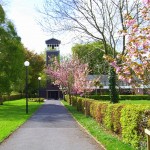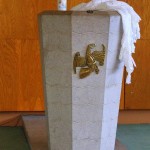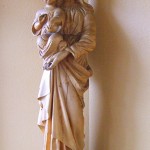Parish History
Brief Parish History & Geographical Location
- On the west side of the Shannon- there was one Parish and one church until 1950- now there are now four parishes and five churches
- In 1950, under the direction of Monsignor Michael Moloney, Parish Priest of St Munchins, the present Church of Our Ladyof the Rosary was built- blessed on December 11th 1950- and first extended in 1956
- Following the death of Monsignor Moloney in October, 1964, Bishop Murphy divided St Muchins’s Parish. The new parish of our Lady of the Rosary came into being at midnight on December 31st, 1964 - Canon W O’Grady was the first Parish Priest
- Of course the links of our faith stretch back many years in our area. In the North Circular Road, opposite Russell Park in the area popularly know as Old Church are the ruins of Kilrush Church which is mentioned in chronicles of 1201 and could date back to 10 century or indeed further. This link with our faith is celebrated yearly nearby with the Dawn Mass on Easter Sunday in the nearby Park
- During these 60 years of faith- 5 Parish Priest and 13 Curates have served in the Parish
- Many members of our Parish have served our Faith as priests, religious and committed laity within Ireland and in many parts of the Word
- The Community has been well served over these years and continues to be blessed by many people who generously gave their time to community endeavours and church linked activities
- The Parish has provided chaplaincy to Munchin’s RegionalMaternityHospital- the Hospital has presently over 5,000 births per year.
- During the boom years of the growing parish and the building of new Estates, the population was noted at 11,000 – presently circa 6,500
- In the years 1950-2010, there have been 7,092 baptism (peak in 1968- 300 baptisms) and 4,112 weddings (peak in 1996-172 weddings
- Our Parish Church- The special Gathering Centre of the faithful- Here members of the parish celebrate the most significant events of their lives as Christians- Baptism, Confirmation, First Communion, Sacrament of Reconciliation, Weddings, Anniversaries, Requiem Masses- and Daily, Weekly Sunday Masses where we come to worship and nourish our faith- From where we are mandated at each Mass as followers of Christ to go and live the way of Christ
- The Community is very well provided for in Educational provision. It has 3 Primary schools- two on the Salesian Convent campus at Fernbank- the Junior school for boys and girls - the Primary School for girls - the John Fitzgerald KennedyMemorial National School for boys.
- There are 3 Second Level Schools – the Salesian Second Level – Christian Brothers Ard Scoil Ris and Villiers Second Level
- Recreation Facilities:- The Limerick Lawn Tennis Club and the Gaelic Stadium
- The Community is also fortunate to have the Russell Memorial Park and the Westfields Preservation Project
Limerick City Parishes
In Medieval Limerick, there were five parishes in Limerick City; St John’s, St Mary’s, St Michael’s, St Munchin’s and St Patrick’s.
In recent times, the boundaries of these parishes have been altered to form the following parishes:
- St Mary’s was divided into St Mary’s and St Nicholas’ (1991).
- St Michael’s was divided into St Michael’s, Our Lady of Lourdes (1963), St Joseph’s (1973) and St Saviour’s (1973).
- St Munchin’s was divided into St Munchin’s, Our Lady of the Rosary (1964), Christ the King (1970) and Corpus Christi (1976).
- St Patrick’s was divided into St Patrick’s, Monaleen (1971), and Our Lady Help of Christians (1981).
- St John’s parish has not been altered.
- St Paul’s was formerly part of the parish of Mungret/Crecora and was created in 1971.
- Our Lady Queen of Peace (1961) and Holy Family (1970) were formerly part of the parish of Donaghmore/Knockea.
Our Lady of the Rosary Church
 Our Lady of the Rosary church is situated on the Ennis Road. It was built in 1950 as a chapel of ease to St Munchin’s parish church. The builders were P. Molloy & Sons. McCormick and Corr designed the church. At the time of construction, it was decided to erect a structure, which could be built quickly, and if necessary could be dismantled and re-assembled elsewhere as the area expanded. The church was designed in a long rectangular plan measuring 115 feet by 34 feet. It was constructed with a light steel frame and external weatherboarding. The roof is made from a steel-framed inclined lattice girder, which was assembled on the ground by welding.
Our Lady of the Rosary church is situated on the Ennis Road. It was built in 1950 as a chapel of ease to St Munchin’s parish church. The builders were P. Molloy & Sons. McCormick and Corr designed the church. At the time of construction, it was decided to erect a structure, which could be built quickly, and if necessary could be dismantled and re-assembled elsewhere as the area expanded. The church was designed in a long rectangular plan measuring 115 feet by 34 feet. It was constructed with a light steel frame and external weatherboarding. The roof is made from a steel-framed inclined lattice girder, which was assembled on the ground by welding.
Bishop Dr. Patrick O’Neill opened the church in December 1950. The church was extended in 1955 and again in 1976 when a fire partially destroyed the sacristy area. Instead of timber, brick was used in the extension but to blend in with the existing building, the brick was covered over with creosoted weatherboard. Bishop Jeremiah Newman opened the new extension on April 29 1979 according to a plaque in the right porch. The architects were McMahon, McMahon & Hickey and the builders were the Lanigan Bros.
On the Ennis Road entrance, on the Campanile, is a life-size statue in white teak of Our Lady of Fatima, carved by Oisín Kelly.
The timber high altar originally had a large dorsal in rich folds of maroon and gold hanging from a tester at ceiling level. The sanctuary area has since been modified to accommodate stained glass windows from St Mary’s Convent.
These stained glass windows over the high altar depict (from left to right) the biblical story of ‘Suffer Little Children’, the Assumption and the Visitation Window of the Sacred Heart to St Margaret Mary Alcoque in Paray-le-Monial, France; The window of the Little Children is to the memory of Margaret Kelly and was donated by her children. The window of the Assumption is to the memory of Mary Anne & Thomas McNamara, and was erected by their son Thomas. Margaret and Marianne Kelly donated the window of the Sacred Heart and Sr Margaret MaryAlcoque to the Sisters of Mercy in December 1885. The Sisters of Mercy in St Mary’s Convent presented these windows to Our Lady of the Rosary parish in 1993. These windows were originally from the Studios of Mayer in Munich.
 In 1993, the silver hanging sanctuary lamp by Br. Benedict Tutty was removed. On the front of the high altar, there are five panels, carved by Bríd Rynne. These are (from left to right) Abraham sacrificing the lamb, Manna from Heaven, the Last Supper, the Wedding at Cana and the Miracle of the Loaves and Fishes.
In 1993, the silver hanging sanctuary lamp by Br. Benedict Tutty was removed. On the front of the high altar, there are five panels, carved by Bríd Rynne. These are (from left to right) Abraham sacrificing the lamb, Manna from Heaven, the Last Supper, the Wedding at Cana and the Miracle of the Loaves and Fishes.
At the rear of the altar on the left, there is a carved statue of the Sacred Heart and on the right; there is a carved statue of Our Lady of the Rosary. These were by the French artist -Yvonne Jammet, a French carver who resided in Ireland. The presidential chair in the sanctuary was a gift from Fr Seamus Power PP in memory of his parents John and Lena Power.
In the right entrance porch, there is a plaque to Christy Barry, parish clerk in the church from 1952 until his death in 1998.
In the main porch, there is a plaque to Tony Doherty, who died on December 9 1963 in London. His colleagues in BOAC at London Airport erected the plaque to his memory- Tony had been an altar boy in this church.
Above the main door of the church, there is a plaster cast of the Deposition of Christ from the Cross by the sculptor, Andrew O’Connor. The original statue was in the Tait Gallery in London and was later transferred to Campion Hall, a Jesuit house in the UK.
On the left wall of the church, are five paintings by Fr Jack Hanlon. The paintings depict (from the back of the church) St Patrick, Pope Pius X, the Holy Family, St Brigid and St Oliver Plunkett.
The Baptismal font is by Thomas Quinn and the design by Liam McCormick. There is a depiction of John the evangelist by Oisín Kelly. The symbol of John the evangelist is the eagle because his gospel writings soar on eagles wings to the very throne of heaven.
Beside the baptistery font, there is a triptych stained glass window, with the Baptism of Christ by Evie Hone as its centerpiece. The other 2 panels are by John and Roisín Murphy and depict the Nativity and the Resurrection.
Beneath the High Altar Stained Glass Windows is the figure of the Resurrected Christ Reaching out to the World – this is from Oberammergau- date 2012
The tabernacle is to the right of the altar. This copper plated tabernacle is by Br. Benedict Tutty of Glenstal Abbey. The cast decorated motif is the ancient christian symbol of Phoenix- (the mythical bird, on finding its young have been attacked, gives its life blood for the preservation of its young), -attributed to Oisin Kelly. The picture of the Immaculate Conception is nearby.
In the little alcove nearby is the church organ- A stained glass window of the Eucharist- and a miniature set of 15 Stations of the Cross from Oberammergau from the year 2011.
In the main aisle of the Church are Stations of the Cross by artisans from Oberammergau – artisans who took part in the performance of the Passion Play of 1950.
On the right side aisle of the church, there are six stained glass windows. They depict (from the back of the church) the Resurrection, the Finding of Jesus in the Temple, the Holy Family, the Adoration of the Magi, the Betrothal of Mary and Joseph and the Annunciation. These windows came from the Studio of Abbey Stained Glass Company in Dublin and were erected in 1979.
 On the rear of the right aisle of the church, there is a statue of the Madonna and Child by Limerick man James Clancy while on the corresponding Left side, there is a statue of St Anne by Eamonn Costello. The vase beside the statue was part of the original furnishings of the church (this vase is not presently in the church).
On the rear of the right aisle of the church, there is a statue of the Madonna and Child by Limerick man James Clancy while on the corresponding Left side, there is a statue of St Anne by Eamonn Costello. The vase beside the statue was part of the original furnishings of the church (this vase is not presently in the church).
Two carved figures, by Imogen Stuart, depicting the Annunciation hung on either side of the north entrance to the church. However, during renovations, these figures were taken down and misplaced.
The church of Our Lady of the Rosary and its contents occupy a significant place in the history of Irish ecclesiastical art. The Shell Guide to Ireland of 1967 rates the church as “one of the more significant recent contributions to Irish Ecclesiastical Architecture and Art”. The building is also a listed heritage building in the City Development Plan of Limerick Corporation.
Old Church Ruin
The Kilrush church ruin is located on the North Circular Road in a housing estate opposite Barrington’s pier. The area around the church was disturbed during the building of the housing estate. A steel frame has been put in place to support the west wall. The west door has inclined jambs and a large lintel. The east window has an unusual circular head and splay arch. The stone window frame in the south wall dates from the 15th century. It was taken from the old Franciscan Abbey in St Mary’s Lane. Robert Vere O’Brien erected this window in Kilrush church in 1900. This window is sometimes called the Quinlivan window.
During excavations, approximately 40 bodies were found buried beneath the Quinlivan window. It is believed that these bodies were buried here in the 16th or 17th centuries. The site is reputed to have been a children’s burial ground.